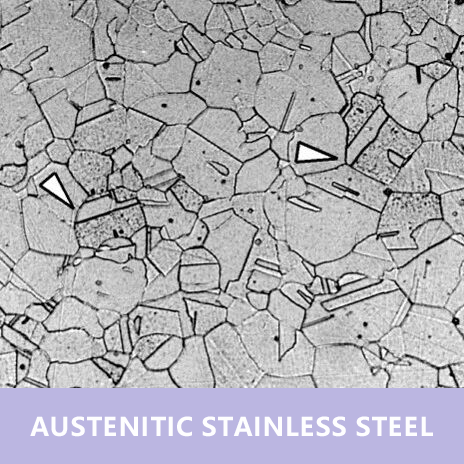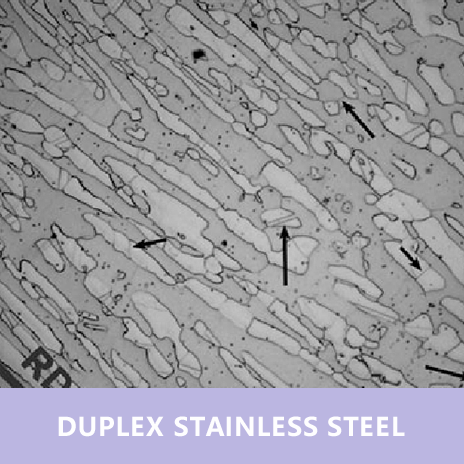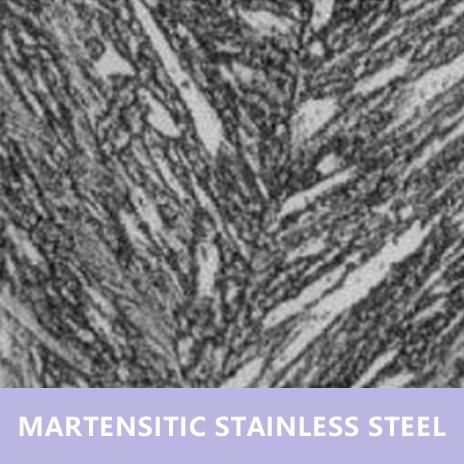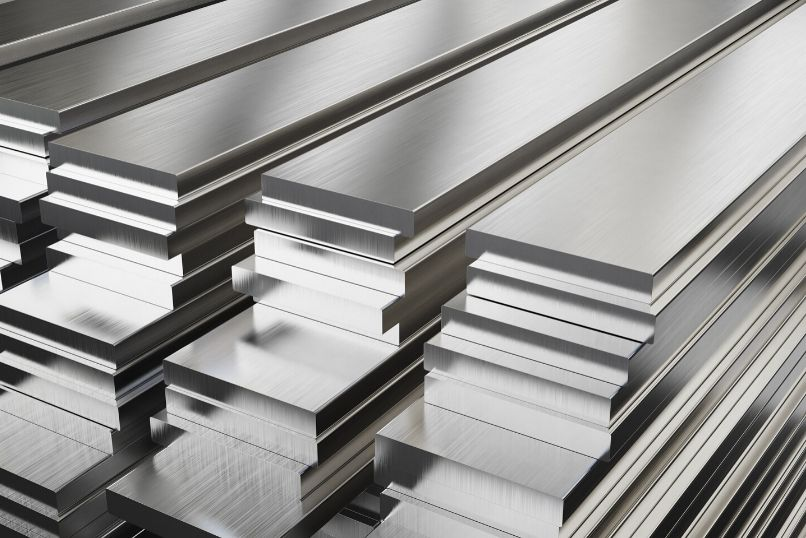Overview of stainless steel
Stainless steel is a group of iron alloys containing at least 11% chromium. Chromium is an element that inhibits iron from rusting and also provides heat resistance to steel. Different types of stainless steel include carbon (from 0.03% to more than 1.00%), nitrogen, aluminum, silicon, sulfur, titanium, nickel, copper, selenium, niobium, and molybdenum. Specific types of stainless steel are usually represented by their AISI three-digit numbers, such as 304 stainless steel.
Stainless steel can be rolled into sheets, plates, bars, wires and tubes. Stainless steel is an ideal material for many applications because it has the strength of steel and the corrosion resistance of chromium. It can be used in many applications such as cookware, tableware, surgical instruments (medical bone plates), major appliances, vehicles, building materials in large buildings, industry and storage tanks and tankers for chemicals and food.
Classification of stainless steel
1. Austenite stainless steel

This is the most common type of stainless steel. Compared with other types of stainless steel, austenite stainless steel has a higher content of chromium, molybdenum and nickel. It is adaptable and is known for its excellent strength and ductility.
2. Ferritic stainless steel

This steel contains 10.5% to 30% chromium. The low carbon content of ferritic stainless steel is usually no more than 0.1%. Ferritic stainless steel is magnetic and is mainly preferred for its resistance to temperature, corrosion and stress degradation cracking.
3. Duplex stainless steel

This steel combines austenite and ferrite, resulting in a metal that is stronger than both. This combination gives the steel higher strength, which can significantly reduce weight. Its corrosion resistance makes it very suitable for use in marine applications.
4. Martensite stainless steel

This steel is structurally similar to ferritic stainless steel, but has a higher carbon content (up to 1.2%), which makes the steel hardenable to a large extent. This steel is particularly suitable for manufacturing medical tools and surgical instruments.

Composition of stainless steel
1. 203 S Stainless steel
Iron (67.775–71.775%), chromium (17–19%), nickel (8–10%), manganese (2%), silicon (1%), carbon (0.15%), sulfur (0.03%), phosphorus (0.045%).
2. 301 S Stainless steel
Iron (70.675–74.675%), carbon (0.15%), manganese (2%), phosphorus (0.045%), sulfur (0.030%), silicon (1%), chromium (16–18%), nickel (6–8%), nitrogen (0.10%).
3. 303 S Stainless steel
Iron (67.44–71.44%), chromium (17–19%), nickel (8–10%), manganese (2%), silicon (1%), phosphorus (0.2%), carbon (0.15%), selenium (0.15%); sulfur (0.06%).
4. 304 S Stainless steel
Iron (66.74–74.5%), carbon (0.07%), manganese (2.0%), silicon (1.00%), phosphorus (0.05%), sulfur (0.03%), chromium (17.50–19.50%), nickel (8.0 – 10.50%), nitrogen (0.11).
5. 304 L Stainless steel
Iron (66.69–74.0%), carbon (0.03%), manganese (2.0%), silicon (1.00%), phosphorus (0.05%), sulfur (0.02%), chromium (17.50–19.50%), nickel (8.0–10.50%), nitrogen (0.11).
6. 303 Se Stainless steel
Iron (67.44 – 71.44%), chromium (17 – 19%), nickel (8 – 10%), manganese (2%), silicon (1%), phosphorus (0.2%), carbon (0.15%), selenium (0.15%), sulfur (0.06%).
7. 316 Stainless steel
Iron (61.995 – 69.095%), carbon (0.08%), manganese (2.0%), silicon (0.75%), phosphorus (0.045%), sulfur (0.03%), chromium (16 – 18%), molybdenum (2.0 – 3.0%), nickel (10 – 14%), nitrogen (0.10%).
8. 316 L Stainless steel
Iron (62.045 – 69.145%), carbon (0.05%), manganese (2.0%), silicon (0.75%), phosphorus (0.045%), sulfur (0.03%), chromium (16 – 18%), molybdenum (2.0 – 3.0%), nickel (10 – 14%), nitrogen (0.10%).
9. 321 S Stainless steel
Iron (65.295 – 70.375 %), carbon (0.08%), manganese (2.0%), silicon (0.75%), phosphorus (0.045%), sulfur (0.03%), chromium (17 – 19%), nickel (9.0 – 12.0%), nitrogen (0.10%), Ti = 5(C + N 0.70%).
10. 347 S Stainless steel
Iron (64.995 – 69.075 %), carbon (0.08%), manganese (2.0%), silicon (0.75%), phosphorus (0.045%), sulfur (0.03%), chromium (17 – 19%), nickel (9.0 – 12.0%), nitrogen (0.10%), Nb = 10(C + N 1.0%).
11. 410 S Stainless steel
Iron (83.53 – 85.53%), carbon (0.15%), manganese (1.0%), silicon (1.0%), phosphorus (0.04%), sulfur (0.03%), chromium (11.5 – 13.5%), nickel (0.75%).
12. 416 S Stainless steel
Iron (82.79 – 87.85%), carbon (0.15%), Mn (manganese) (1.25%), silicon (1.0%), phosphorus (0.06%), sulfur (0.15%), chromium (12 – 14%), Mo (molybdenum) (0 – 0.6%).
13. 418 S Stainless steel
Iron (82%), chromium (13%), W (tungsten) (3%), nickel (2%).
14. 431 S Stainless steel
Iron (78.23 – 83.75%), carbon (0.20%), manganese (1%), silicon (1%), phosphorus (0.04%), sulfur (0.03%), chromium (15 – 17%), nickel (1.25 – 2.50%).
15. 440 C Stainless steel
Iron (79.15%), chromium (17%), carbon (1.1%), manganese (1%), silicon (1%), molybdenum (0.75%).
16. 13-8 PH VAR Stainless steel
Iron (74.122 – 77.35%), carbon (0.05%), Mn (manganese) (0.10%), silicon (0.10%), phosphorus (0.010%), chromium (12.25 – 13.25%), nickel (7.5 – 8.5%), molybdenum (2.00 – 2.50%), nitrogen (0.010%), aluminum (0.90 – 1.35%).
17. 15-5 PH VAR Stainless steel
Iron (71.91 – 77.71%), carbon (0.07%), manganese (1.0%), sulfur (0.040%), sulfur (0.03%), silicon (1.0%), chromium (14.0 – 15.50%), nickel (3.50 – 5.50%), Cu (copper) (2.50 – 4.50%), Nb+Ta (niobium + tantalum) (0.15 – 0.45%).
18. 17-4 PH VAR Stainless steel
Iron (73%), chromium (15.0 – 17.5%), nickel (3.0 – 5.0%), Cu (copper) (3.0 – 5.0%), manganese (1.0%), silicon (1.0%), Ta (tantalum) (0.45%), Nb/Cb (niobium) (0.45%), Nb + Ta (0.15 – 0.45%), carbon (0.070%), phosphorus (0.040%), sulfur (0.030%).



